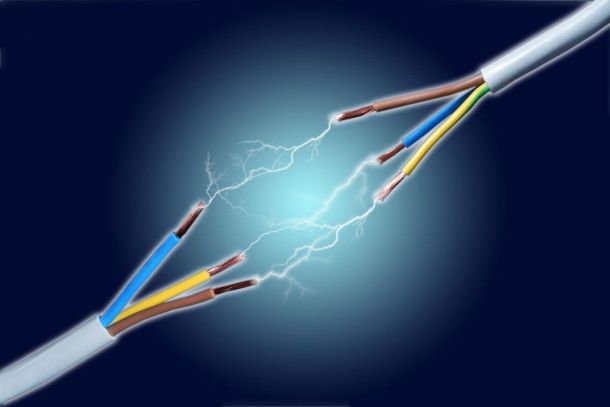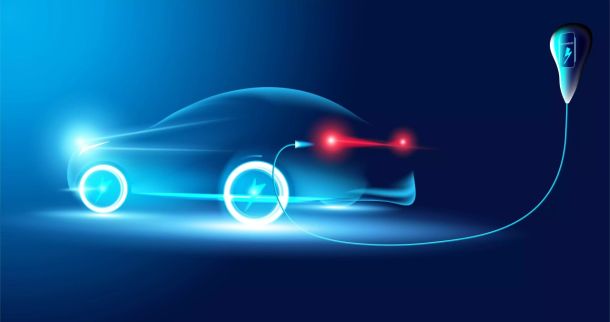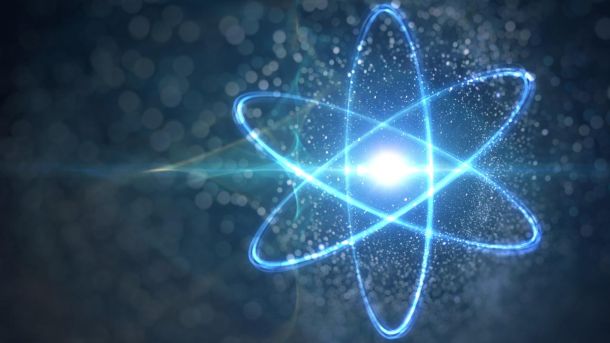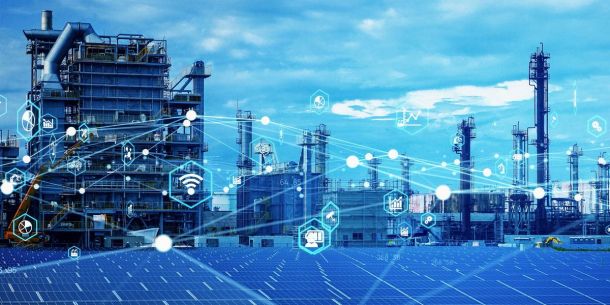INCONCRETO NEWS
Exploring the Latest Frontiers in Hydrogen Applications
Fuel cells: the instruments for using hydrogen as a source of energy
Hydrogen represents a very strong ally in producing electricity in clean and sustainable forms. The perfect instrument facilitating such impactful results, at the core of worldwide ambitions today, are hydrogen fuel cells.
Hydrogen fuel cells generate electricity using a chemical reaction. Each fuel cell has two electrodes: a negative anode and a positive cathode. At the level of these electrodes, electricity is produced through the combination with an electrolyte carrying electrically charged particles between them. A catalyst contributes to speeding up these reactions. In this framework, hydrogen is the main element of the fuel cell, along with oxygen which is equally indispensable for the cell to work.
Hydrogen fuel cells represent the opposite of electrolysis, which we presented in the first part of our publication in January, and whose process consists of the decomposition of water (H2O) into its basic components, hydrogen (H2) and oxygen (O2), through the passage of an electric current.
One of the major advantages of fuel cells is that they generate electricity with very minimal pollution compared to traditional combustion-based technologies, as hydrogen and oxygen used to create the electricity are the main elements producing water as a by-product. Moreover, cells which use pure hydrogen (H2) as fuel are entirely carbon-free. Fuel cells are also highly reliable and quite silent during operation as they have reduced moving parts than combustion technologies.
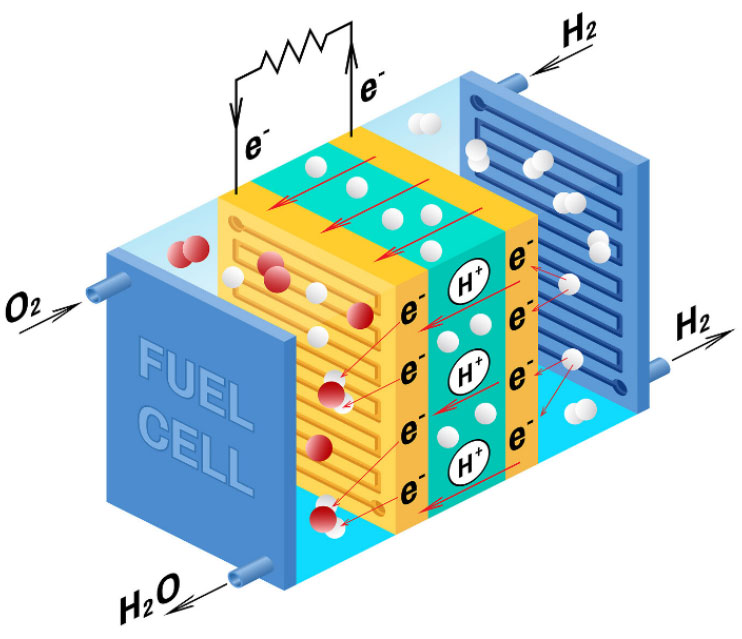
Source: Airbus
Taken as single elements, fuel cells do not generate a large amount of electricity. Therefore, they are assembled into stacks to ensure sufficient power generation for their intended purpose. Fuel cells are used in a significant variety of applications, from transportation to emergency backup power. They can power systems as large as a power plant or as small as a laptop.
While fuel cells function similarly to batteries, they do not require to recharge and may keep producing energy as long as hydrogen is available. We can consider that hydrogen fuel cells are durable, secure, efficient and tools and that their scalability ensures high levels of flexibility.
On the other hand, some challenges include the cost of the entire structure, which rises due to the use of platinum as one of the largest component materials, even if research is ongoing to develop alternative materials that are less expensive and more abundant than platinum. Another disadvantage is represented by the cost of hydrogen, whose extraction, as we have already highlighted, can take a lot of energy to achieve, undermining the green benefits of a fuel cell application. In addition, it is necessary to provide the infrastructure that can support the growth in fuel cell use, especially for transportation, also considering the flammable nature of hydrogen, which poses relevant safety concerns.
Hydrogen applications in transportation
Fuel cells allow the use of hydrogen for various transport applications, from automobiles to buses, from motorcycles and bicycles to scooters, and from ships to trains and aircraft.
Automobiles based on hydrogen fuel cells can cover distances from 500 to 600 kilometres between two sessions of refuelling, and refuelling takes less than five minutes to complete, making this technology highly competitive against battery-based electric cars that take much longer to charge. It is estimated that fuel cells for vehicles running on hydrogen gas consume around 40% less energy and provoke 45% fewer greenhouse emissions than internal combustion engines. The challenge with hydrogen-based vehicles is mainly related to hydrogen extraction or production, storage and transport.
As Stellantis highlights, there are two possible architectures for fuel cell electric vehicles:
- a full-power configuration, where a fuel cell is the primary source of propulsion under all operating conditions. In this case, a large and robust fuel cell is supported by a small battery for recapturing braking energy, providing extra power during short acceleration events, and smoothing out the power delivered from the fuel cell with the possibility to turn off the fuel cell during low power needs.
- a range-extender configuration, where a battery-electric vehicle with a large battery is combined with a small low-power fuel cell that extends the range of the vehicle by supplying power to the battery. However, since its power is substantially reduced, the fuel cell cannot propel the vehicle when the battery is empty.
Concerning passenger vehicles, two hydrogen-powered models are publicly available in select markets: Toyota Mirai and Hyundai Nexo. Toyota Mirai first rolled out at the end of 2014 and was distributed mainly in the Los Angeles area of California. Other specific European markets, including the UK, Germany and Denmark, were added the following year. By the end of 2019, more than 10,000 Mirai had been sold.
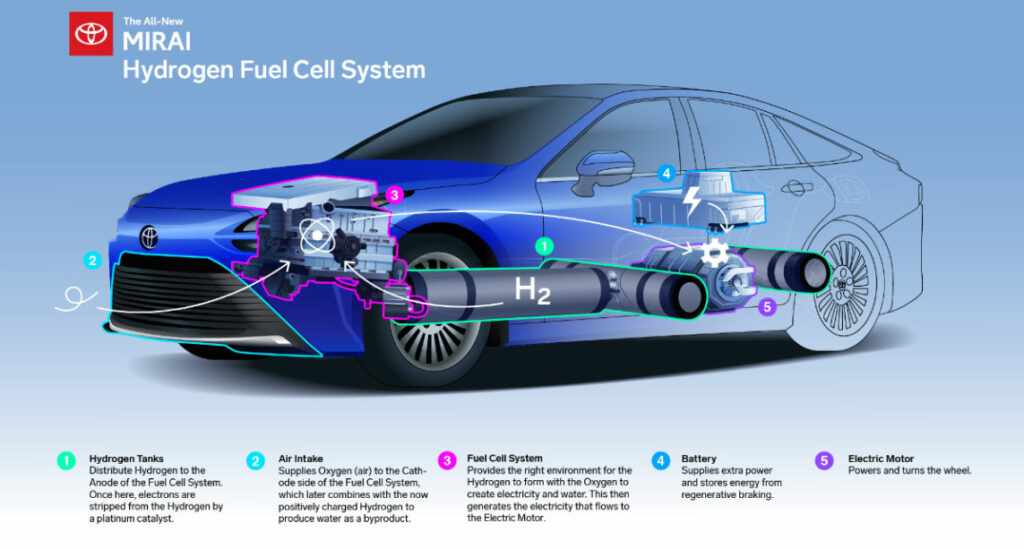
Source: Toyota
Other large automakers such as BMW, Ford Motor Company, Nissan, Mercedes Benz and Renault are currently implementing research and development activities to leverage the potential for hydrogen as a zero-emission passenger vehicle fuel, also launching specific collaborations for the purpose. On the other side, in January 2023, Thomas Schäfer, CEO of Volkswagen, stated that hydrogen is a far too expensive source, and not competitive enough, clarifying that the ambitions of its group to participate in the transition to sustainable mobility will be deployed through other technologies.
Nevertheless, like other automakers, Volkswagen does not exclude the application of hydrogen for heavier-duty and logistics-related vehicles, including buses, long-haul trucks, forklifts, and heavyweight machinery, among others.
The case of Stellantis is emblematic. In October 2022, President Carlos Tavares, while visiting the Hordain site in the northern Hauts-de-France region, announced the mass production of Peugeot, Citroën and Opel light commercial vehicles in a hydrogen-powered version equipped with a fuel cell. This industrialization of hydrogen-powered light commercial vehicles – accompanied by €10 million in investments with financial support from the French government – is a new step for this plant, where 43% of models for the Peugeot, Citroën, Opel, Vauxhall, Fiat and Toyota brands are already available in a zero-emission electric version. Vehicles with a fuel cell – the so-called K-Zero models – are intended for long-distance freight professionals who require a more extended range (400 km), the fastest possible charging time (3 minutes) and no compromises on charging capacity (1000 kg of payload).
Another significant driver in demand for hydrogen fuel is forklift trucks. Since they frequently operate indoors, where emissions must be controlled, forklifts are mostly electrical. In the employment of electric forklifts, fuel cells have advantages over batteries, such as quicker refuelling and a lack of degradation at low operating temperatures, as in refrigerated warehouses.
Some crewed aerial vehicles also employ fuel cells, frequently in conjunction with other technologies. In unmanned aerial vehicles and for auxiliary power on aircraft, fuel cells are used more often to replace fossil fuels for tasks like starting engines and powering onboard electrics. Some countries have employed fuel cells to enable submarines to remain submerged for weeks while improving silent running operations. Fuel cells have also been used for tourist boats (called Nemo H2) on Amsterdam’s canals. In addition, clean energy, zero-emission trains have been launched in recent years: they release only steam and condensed water and emit low noise levels, using a combination of hydrogen fuel cells with battery energy storage.
Other possible scenarios for hydrogen applications in transports system go beyond fuel cells, aiming to develop hydrogen engines which are becoming an essential component in low-carbon mobility.
Gaétan Monnier, director of the Transport Results Center at Institut Français du Pétrole Energies Nouvelles, highlights that at the European level, “the initial objective was to consume hydrogen in fuel cells, […] but the idea of burning hydrogen directly in thermal engines has been gaining interest for a few years among researchers and manufacturers”.
In order to be adapted for burning hydrogen, existing combustion engines would require some technical adjustments, such as the integration of metals capable of resisting at higher temperatures. An injection system adapted to this highly volatile fuel, as well as the review of the control of combustion since hydrogen characteristics are very different from those of diesel. This solution would allow manufacturers to keep their production line and thus not increase their prices too much.
Fuel cells can indeed offer better energy efficiency (up to 65%) than the hydrogen engine (up to 45%), and even if the hydrogen engine appears to be less expensive to invest in, experts believe that it might be slightly more fuel-intensive over the vehicle’s life cycle. Ultimately, both could have their economic relevance depending on the intended use of the specific means of transport.
Hydrogen has enormous potential as a cleaner fuel for transportation, but using it in aviation poses unique challenges. One major obstacle is the low density of hydrogen gas, which takes up much more volume than traditional fuels like kerosene. Additionally, hydrogen must be kept at an extremely low temperature of -253°C to remain liquid, requiring specialized storage tanks that cannot easily be housed in an aircraft’s wings or fuselage. As a result, aviation manufacturers are exploring alternative approaches, such as using synthetic fuels derived from hydrogen in existing turbines. Similarly, the maritime industry is exploring the use of ammonia, a hydrogen derivative already handled by port infrastructure and remains in a liquid state at -33.5°C.

Source: Energy Strategy Reviews 44 (2022)
Therefore, the path for carbon-negative mobility will not be ensured by only one specific technology and will be based on multiple coordinated solutions.
Hydrogen applications for heating
Hydrogen is expected to possibly become an important growing ally in developing sustainable forms of heating. In buildings, hydrogen could be blended into existing natural gas networks, with the highest potential in multifamily and commercial buildings, particularly in dense cities, and providing the immediate effect to reduce greenhouse gas emissions.
Another option, still to be tested and verified and corresponding to longer-term prospects, would be switching to a 100% hydrogen heating system. However, this alternative is not viable at the moment, particularly because the infrastructure allowing to produce hydrogen in large and sufficient amounts is still being developed. Moreover, hydrogen and methane gases have some crucial differences – such as the speed at which the gas travels – so it will be essential to understand how the existing gas pipeline network will perform when hydrogen is introduced into it.
Lastly, fuel cells are also used to produce heating-related energy: hydrogen is employed as a “fuel” without being burnt, but it reacts with oxygen and generates electricity and heat.
INCONCRETO, as an international consultancy, can provide expertise in capital project optimization and oversee critical paths for innovative industries.
Connect with our team!
We combine technical expertise with large program execution practices, improving predictable outcomes and steering profitability on Capex/Opex project investments.
For further reading, you may consult these sources:
The Future of Hydrogen, by the International Energy Agency
Il futuro dell’idrogeno, by Dirigenti Industria
What is a hydrogen fuel cell and how does it work?, by TWI Global
Hydrogen Fuel Cell Technology, by Stellantis
Hydrogen in transport: everything you need to know in 10 questions, by Polytechnique Insights
Volkswagen ne croit pas à l’hydrogène à moyen terme, by motor1.com
Challenges in the use of hydrogen for maritime applications, in Energy & Environmental Science Journal Climate-Tech to Watch: Hydrogen-Powered Aviation, by Information Technology & Innovation Foundation
Newsletter
© INCONCRETO. All rights reserved. Powered by AYM






